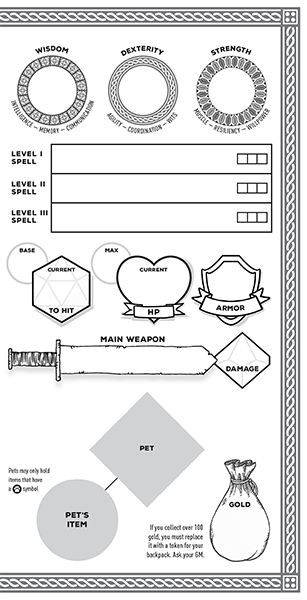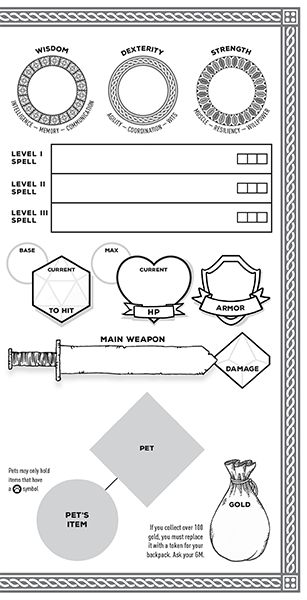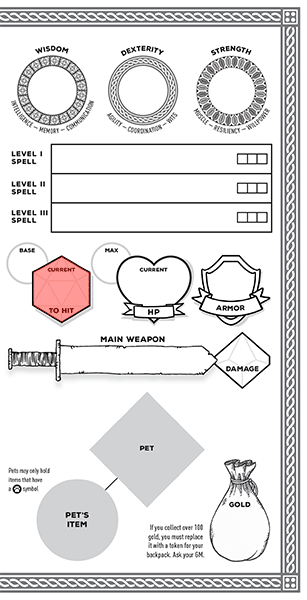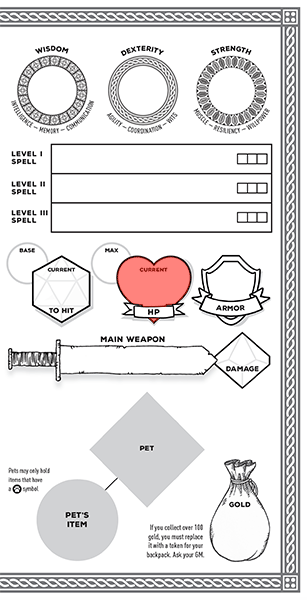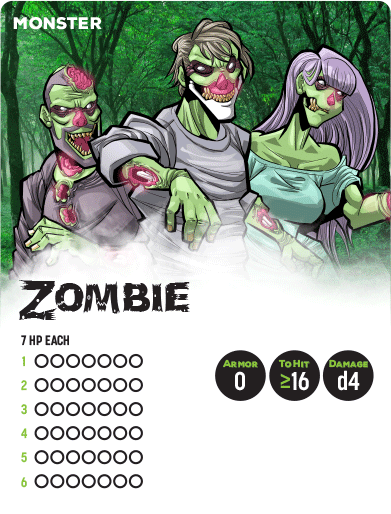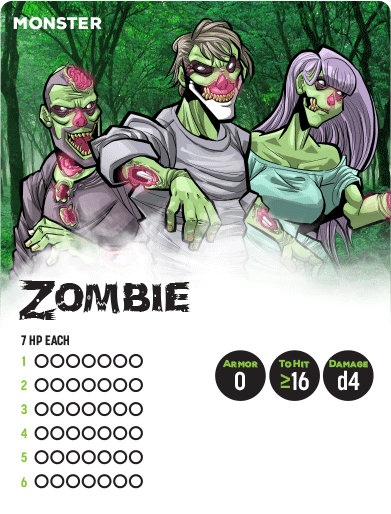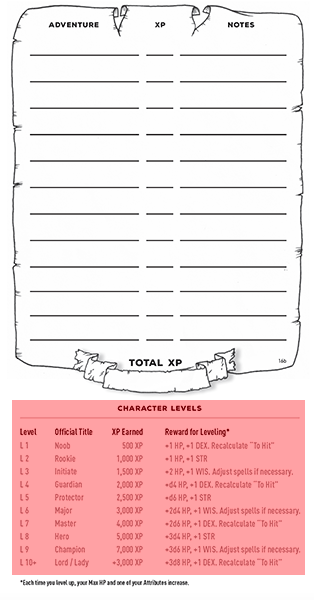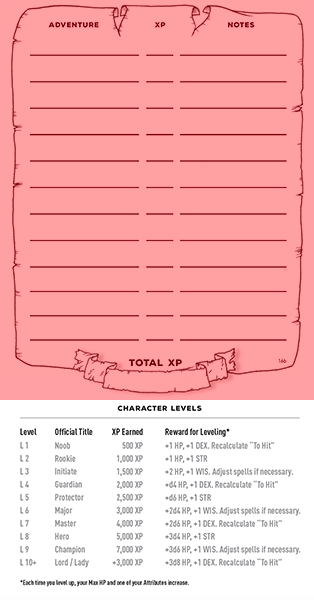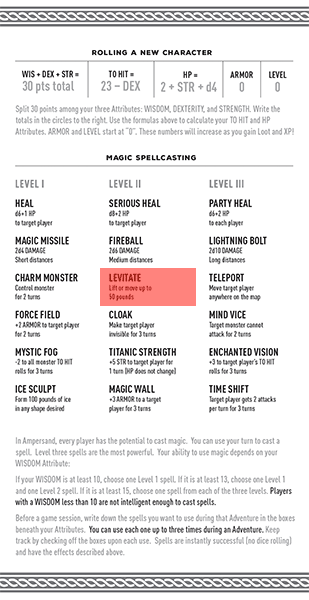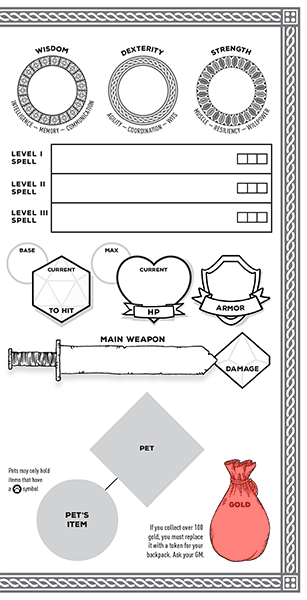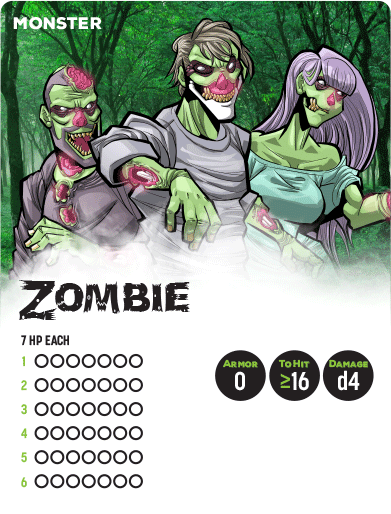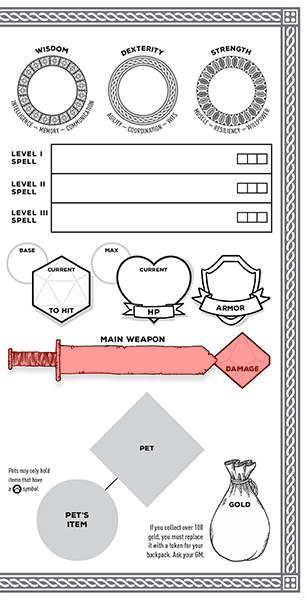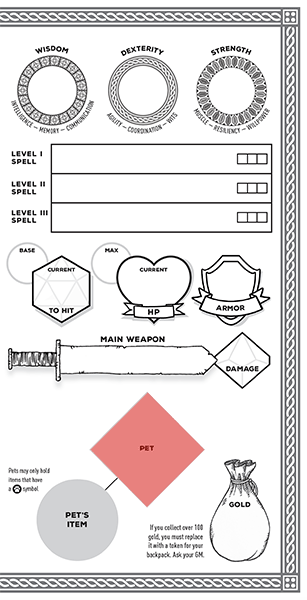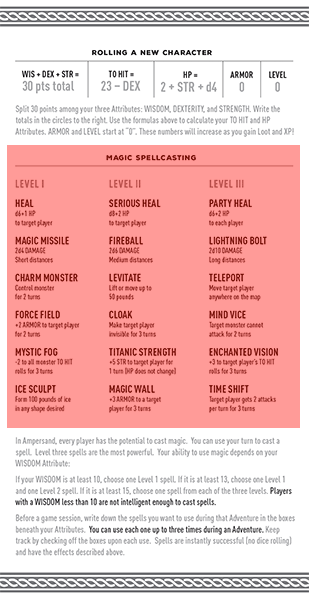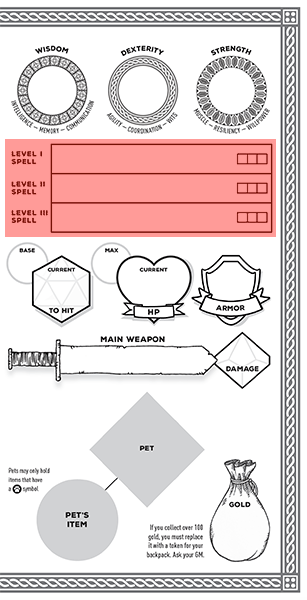AMPERSAND GLoSSARY
Confused by terminology or a feature of gameplay? The explanations are all right here.
Players roll a d20 against one of their Ability Scores to see if they are successful. This is also known as a Complex Action. For example, a Player attempts to lift a boulder. Since this will require some muscle, she needs to roll against her Strength (STR) Ability Score. Her STR is 15, so this means she needs to roll a 15 or less to be successful. Specific Ability Checks are included in all Adventures, but, like in this example, the GameMaster will also have to improvise and decide which Ability Score to roll against depending on a given Player's intention. You make the call!
Three Ability Scores — Strength, Wisdom, and Dexterity — make a Character unique and determine what he or she is able to do in the game. When creating a new character, the player is asked to distribute 30 points among these three abilities with the condition that no ability should have a score lower than 3 or higher than 18.
For example, a new Character could be strong and good with weapons with a relatively high Strength score of 15 and Dexterity of 10, but there would only be 5 points left for Wisdom. So while epic in hand-to-hand combat, perhaps that Character isn't too bright and certainly not clever enough to Cast Spells.
For example, a new Character could be strong and good with weapons with a relatively high Strength score of 15 and Dexterity of 10, but there would only be 5 points left for Wisdom. So while epic in hand-to-hand combat, perhaps that Character isn't too bright and certainly not clever enough to Cast Spells.
Much like a play, every Ampersand Adventure is cut into two or more Acts. This is to give a natural break in the gameplay with each Act roughly corresponding to a single gaming session. The GameMaster will be able to see the Acts clearly indicated in the text on the inside of the ScreenBox. If you're having fun, there's nothing wrong with playing through all Acts in one marathon gaming session — just make sure to take breaks and have snacks.
Each Ampersand Adventure is a self-contained, stand-alone story that includes all of the materials (Maps, Dice, Monster Cards , etc) that you need to play! Most Adventures will have a Level rating on the box, indicating the recommended Character Level for that Adventure. The first Adventure, Mages & Macrophages, is a beginner Adventure rated for Levels 0 to 3. But future releases will be rated for higher level Characters. Foes in these higher level stories will be more difficult to defeat, but by the time Players reach those levels, they will have the experience, ability and Loot Tokens to handle that challenge!
A Non-Player Character in the story that is usually friendly and can become a member of the Party. The GameMaster plays the role of all Allies.
A Player or Monster has an ARM attribute primarily based on their equipment. When attacked, damage taken is reduced by this amount. For example, if a Monster successfully hits a Character with a weapon that would normally inflict 9 HP DAM, a Character wearing enough armor to have an ARM score of 2 (say, wearing two items that are each labeled +1 ARM) would only sustain 7 HP (9 – 2 = 7) of Damage.
This is a modifier usually given by equipment, and is applied to a Player's "To Hit" attribute, making it easier or harder for a successful attack. For example, if a Player's Base To Hit is 12 and a sword gives a "+1 ATT" bonus, you can update your "To Hit" to an easier 11 roll on a d20. Note: items like cursed weapons will modify a Player's To Hit to make it harder to land a successful hit.
The base number needed for a successful attack. It is calculated as "23 – Dexterity". For example, if a Character's DEX is 13, her "Base to Hit" would be 10. "Current To Hit" is the base number modified by tokens or spells and is used in gameplay.
A Non-Player Monster that is typically the hardest to defeat and usually an important actor in the story. The GameMaster plays the role of all Bosses, deciding actions for them, giving voice to their thoughts, and rolling for them during combat. The boss will always have a Monster Card included in the Adventure.
See Health Bubble
This is a player's avatar in the game. All of the necessary information for a Character (Ability Scores, possessions in the form of Loot Tokens, Magic Spells, etc.) is contained in the Character Folio. Players can use the same Character over the course of several different Adventures or make a new one every time they play!
This is the white, tri-fold paper folio that describes a Character avatar. It has slots to carry Loot Tokens, has all the statistics needed to play written inside (in pencil!), as well as a list of all spells a Player can cast. There's some reference rules and charts, and a place to keep track of Experience Points (XP) and Gold. Players should create a memorable name and spectacular color drawing of their Character on the front of their Folio.
Combat or Attacking is one of the three actions a player can make with their Character in the game. Unlike a Complex Action, during Combat, the Player is rolling against her "To Hit" instead of specific Abilities. and the Player is trying to roll greater than or equal to that number to succeed. A roll of 20 is a "Critical Hit" and incurs double damage. A roll of 1 is an "Epic Fail" and something unexpectedly tragic occurs, like the Character's sword flying across the room and getting stuck in a wall. On the Monsters' side, the GM rolls for them in the same way. Please check out a more detailed example of Combat.
This is any non-trivial feat which has a possibility of failing. A d20 is rolled to evaluate success. Complex Actions are rolled against one or more the Player's personal Wisdom, Dexterity, or Strength Ability Scores. The GM decides which Abilities should be used, averages them together (if more than one is used), then asks the Player to try to roll lower than or equal to that number to succeed. A Complex Action is different than Combat which has its own kind of roll. For a more thorough explanation, see an example of a Complex Action.
One of the seven basic Tribes. This large category covers any anthropomorphized animal that is smart enough to figure out how to use objects and speak. Were-rats, cat-people, mutant rabbits — a Player can decide how civilized or feral he wants to play his Critter Character!
This is the current number of Health Points (HP) that a Player has at any time during play. documented in the Character Folio. Current HP will decrease as Players sustain damage or increase as they are healed by Loot or Spells. Current HP should never be greater than a character's Max HP.
This is a number that a Player has to roll greater than or equal to in order to land a successful attack with their equipped weapon. Starting with their Base To Hit score players add bonuses or subtract penalties from their equipped Loot Tokens or Spells that have been cast upon them. As the Character changes weapons or switches Loot, this number can change, so make sure to keep it updated!
A Monster's To Hit is written right on their Monster Card. This example shows that Zombies need to roll a '16' or above to land a hit: The GameMaster rolls for all Monsters.
The GameMaster rolls for all Monsters.
A Monster's To Hit is written right on their Monster Card. This example shows that Zombies need to roll a '16' or above to land a hit:
This is the nomenclature for the different dice used in the game for specific situations. The "d" means die and the number following it is the number of faces. Placing a number in front tells you how many to use. For "3d10" for example, you can either roll three d10s simultaneously, or simply roll a single d10 three times, summing the resulting numbers in either case. A d2 is a coin flip (heads = 1, tails = 2) or the even/odd result of any die (odd = 1, even = 2).
Sometimes there is a modifier after the die name that's applied to the roll result. For example, "d20+2" adds two more to a twenty-sided die roll result, so rolling a "10" would actually result in a "12".
Every Ampersand Adventure comes with a complete set of six dice. Extra d20s (for the players) are included for your convenience too!
Sometimes there is a modifier after the die name that's applied to the roll result. For example, "d20+2" adds two more to a twenty-sided die roll result, so rolling a "10" would actually result in a "12".
Every Ampersand Adventure comes with a complete set of six dice. Extra d20s (for the players) are included for your convenience too!
This is the amount subtracted from the Health Points of a Character, Ally, or Monster when successfully hit during Combat. The Damage is expressed as the die type to roll. For example, "d6+1" would mean to roll a six-sided die and add one to determine the Damage inflicted. Each weapon's Loot Token will have its DAM description written on the front of the token.
Monsters and Allies will also have Damage dice, but it is not from a Loot Token — you can find their Damage right on their Monster Card. This example shows that these Zombies will roll a d4 for Damage upon a successful hit:
Monsters and Allies will also have Damage dice, but it is not from a Loot Token — you can find their Damage right on their Monster Card. This example shows that these Zombies will roll a d4 for Damage upon a successful hit:
One of the three Ability Scores for Characters. Dexterity is the measure of the mental and physical agility, coordination, and wits of a character. It's chiefly used to determine how successful you are at attacking a target, effecting the calculation for "To Hit". It is often used to determine success of a Complex Action such as jumping gorges, catching falling objects, or knabbing lurkers in the shadows, as well as fine motor skill actions like throwing objects, juggling or knitting.
The dice are the crucial tools to determine the outcomes in every Ampersand Adventure. A full, color-matched set is included in each ScreenBox. Sometimes extra dice are included as well. Generally the GameMaster will keep a complete set to use behind the screen, while the players hang on to a couple of d20s nearby. If there is a situation where the players need to roll (such as determining weapon Damage) the GameMaster can hand over the appropriate dice for the players to roll.
While the concept of encumbrance is not really a part of the Ampersand gaming system, the token slot character sheet takes care of managing a reasonable amount of gear that a character can carry. One exception is that if a character accumulates 100g gold coins in treasure, he is required to trade it in for a 100g token which they must use in a bag slot to represent carrying all that weight. Otherwise, don't worry too much about encumbrance.
When a player physically inserts a Loot Token in a token slot on her Character Folio, her character has "equipped" that item, armor or weapon. If the character uses a consumable item like a potion, she must "unequip" and surrender that token back to the GameMaster, as it is a one-time use. Reusable items like a Bow or Magic Talisman can be kept, but must be put in a backpack or pocket slot or left on the ground (i.e. physically placed on the map where the figurine is standing). Another player (or monster) can of course pick it up for their use. It's up to the GameMaster's discretion but the time it takes to equip or unequip a weapon from her backpack, drink a potion, trade an item with another nearby player, or pick-up an item off the ground should take one Turn to do.
One of the seven basic tribes. This category of creature are bipedal (stands on two feet), hard-shelled insectoid or crustacean-like creatures. You can create a character resembling things like ants, scorpions, beetles, praying mantises as well as crabs and lobsters. These creatures tend to have no bones but instead have more of a hard outer shell.
These are points that Characters earn for acts of bravery, combat prowess and accomplishing feats in an Adventure. At certain milestone amounts, the Character can advance in Level to earn bonuses to their Ability Scores and Health Points. This will directly improve the Character's "To Hit" and number of Spells she can utilize. A chart explaining the Levels with their XP milestone amounts is located on the back of the player's Character Folio. The GameMaster will bestow XP rewards to the players at the end of each Act or perhaps at the end of the Adventure. There is a chart in the GameMaster's notes on the inside of the ScreenBox — that only the GM is allowed to see — giving guidance on how to allot XP for players. After completing an Act or even an entire Adventure, Players should write down their XP (and some interesting adventure events in the notes) to track their history.
Every Ampersand Adventure comes with a complete set of cardboard Figurines and plastic stands. Every Monster, Boss and Ally in the story is represented. Also in every box, a complete set of seven Tribe Player Figurines is included. These are easy to identify because they will always have a white border. As you obtain more Ampersand Adventures, you'll find a unique set of Player Figurines comprised of the same seven Tribes in each box. You can use your favorite one each and every adventure... or change it up as you wish. During play, Figurines are placed directly on the map and represent where these characters are standing. Orientation and positioning is important for the GameMaster to determine how events transpire.
Note to the GM: If players start to get a little "handsy" with the figurines and arbitrarily move them around, you can set a rule that the GM should be the only one to manipulate them... with a possible penalty of losing their next Turn
Note to the GM: If players start to get a little "handsy" with the figurines and arbitrarily move them around, you can set a rule that the GM should be the only one to manipulate them... with a possible penalty of losing their next Turn
The creatures from the seven Player Tribes in general cannot naturally fly. However there are some Spells that will allow Players to levitate and even fly. But these are temporary conditions. For example, there is a Level II Spell which will allow the caster to levitate up to 50lbs. While this is handy for lifting rocks and treasure chests, this could also be another player (or the caster himself) if the weight is right. For these types of spells, it's up to the GameMaster how long this lasts. A good guideline is rolling 2d6 to determine number of turns for the spell's duration.
which will allow the caster to levitate up to 50lbs. While this is handy for lifting rocks and treasure chests, this could also be another player (or the caster himself) if the weight is right. For these types of spells, it's up to the GameMaster how long this lasts. A good guideline is rolling 2d6 to determine number of turns for the spell's duration.
The storyteller/referee for the game that is in charge of telling the story and playing as the Monster and Allies. The GameMaster, or "GM", does not have a character in the game, but instead narrates the story text, facilitating the adventure for the players (kids). There will be passages in the story for GM's eyes only which must be kept secret from the players and revealed as the story progresses. The GM is usually a parent, but anyone who is willing can be the GameMaster.
This is the cardboard case within the ScreenBox that contains secret information about the Adventure. Under no circumstance should the Players see the materials contained within before the story asks for them. Only the GameMaster is allowed to sort through these game pieces and extract them as needed. Typically the Portfolio will contain the Map Tiles, Puzzle Card, Monster Cards and Lil-Ra's Vendor Book.
The official currency in every Ampersand Adventure. It is sometimes shortened as just the letter "g", as in 25 Gold is 25g. Gold is exchanged for goods and services... and sometimes bribes or deals between monsters and even other players. Most monster battles result in loot that includes Gold. Unlike every other treasure and loot in the game which is in the form of a Loot Token, Gold is a virtual asset and should be tallied as it's earned. Write your total Gold in pencil on the characters' Character Folio sheets. The one exception is when a character has accumulated 100g. When that occurs, the player must tell the GM who will provide a special "100g" Loot Token which must immediately be placed on the character's body in the backpack or pocket slot... or even a free hand. The reason for this is to simulate a character carrying this massive amount of gold coins -- it would take up space.
The one exception is when a character has accumulated 100g. When that occurs, the player must tell the GM who will provide a special "100g" Loot Token which must immediately be placed on the character's body in the backpack or pocket slot... or even a free hand. The reason for this is to simulate a character carrying this massive amount of gold coins -- it would take up space.
One of the seven basic tribes. These large and lumbering half-human / half-giant creatures tower over most of their other party members. While they are physically larger than other tribes, they do not gain any additional Health or Strength bonus, nor any penalties to their Wisdom... so go ahead and create a mystical, spellcasting Wizard Half-Giant! One thing for sure is all Half-Giants are dependable at reaching things on the top shelf.
The small circles in a numbered row on a Monster Card. Fill-in one bubble with a dry-erase pen for each point of damage inflicted. Once all the bubbles are filled in that row, the Monster is defeated.
A number that represents how healthy you are. Every attack or injury reduces this number. A monster dies when its HP is reduced to 0. A Player falls unconscious when his or her HP is reduced to 0, and will require a resurrect potion or spell from an ally or fellow player. Players can't die in this game.
One of the seven basic tribes. If you create a character that is human, it's basically just like your real self in real life.
One of the seven basic tribes. Characters in this category are any small-bodied creatures like dwarves, goblins, gnomes, etc. They are handy to get into small spaces. Despite their physical size, they suffer no penalties or bonuses to their Ability Scores.
In traditional RPG games, initiative plays a large role in determining the order of events in an encounter with monsters. In general you probably won't need to use initiative in Ampersand gameplay. Simply allow players to take actions before the monsters, executing them in the order the GM receives them. If a situation occurs with simultaneous Simple or Complex Actions (or if the players start to get out of control), you can create some order by "rolling for initiative". Have players involved each roll a d6. The GM rolls for each of the Monsters or Allies. Tying rolls can either get re-rolled or the GM can manage those actions as if they were occurring simultaneously. Subsequent turns can be kept in this same established order, or you can roll again each turn as needed.
As characters gain Experience (XP) when completing Acts across multiple Adventures, they will hit experience level milestones called Levels. Each level attained will give bonus Health and Abilities points. The back of the Character Folio has a chart of the leveling milestones. Newly-created Characters start at Level 0. As you increase in Level, make sure to update the box on the front of the Character Folio.
Lil-Ra is a mysterious mini mummy who appears in the middle of every Adventure, peddling his wares in the form of Loot Tokens from his Vendor Book. In some adventures Lil-Ra may play a key role in the story and may even have his own Monster Card. Perhaps you can convince him to join your party and assist in your adventure! Other times the transient and teleporting tyke may have just visited you to make a quick buck. In any case, look out for him in every Adventure.
The small paper discs in the game are called Loot Tokens. They fall into these types:
REGULAR TOKEN: These represent the things your Character can carry such as weapons, armor, magic items, potions, jewelry, gems, and other equipment. These all fit in slots around your character's body and backpack located on the Character Folio.
PET TOKEN: In your travels, you may discover a diamond-shaped Loot Token representing a Pet. You can have only one of these per character. It represents a loyal and helpful companion that can be traded, sold, or given to others as a gift. It has a specific slot on the Character Folio. The pet can carry one pet-compatible Loot Token.
BUFF TOKEN: Players may normally only have one regular Loot Token per slot. However there are special ring-shaped tokens called "Buffs". To equip and benefit from these, they must stack with a compatible full-circle regular Loot Token in an item slot.
100G TOKEN: There is a special Loot Token representing 100 Gold which must be used when your character has accumulated that amount of Gold. Representing the weight and size of that many coins, it will take up a backpack or pocket slot.
Most Loot Tokens will fit in a logical slot on your Character (e.g. Sword on the hand. Helmet on the head.) Sometimes you might run into some weird item you'd like to use in an unusual way (e.g. Garbage Can Lid as a shield. Frying Pan as a Cudgel). Check with your GameMaster to see if it's ok to use it in that way. It's the GM's decision to allow it or not.
REGULAR TOKEN: These represent the things your Character can carry such as weapons, armor, magic items, potions, jewelry, gems, and other equipment. These all fit in slots around your character's body and backpack located on the Character Folio.
PET TOKEN: In your travels, you may discover a diamond-shaped Loot Token representing a Pet. You can have only one of these per character. It represents a loyal and helpful companion that can be traded, sold, or given to others as a gift. It has a specific slot on the Character Folio. The pet can carry one pet-compatible Loot Token.
BUFF TOKEN: Players may normally only have one regular Loot Token per slot. However there are special ring-shaped tokens called "Buffs". To equip and benefit from these, they must stack with a compatible full-circle regular Loot Token in an item slot.
100G TOKEN: There is a special Loot Token representing 100 Gold which must be used when your character has accumulated that amount of Gold. Representing the weight and size of that many coins, it will take up a backpack or pocket slot.
Most Loot Tokens will fit in a logical slot on your Character (e.g. Sword on the hand. Helmet on the head.) Sometimes you might run into some weird item you'd like to use in an unusual way (e.g. Garbage Can Lid as a shield. Frying Pan as a Cudgel). Check with your GameMaster to see if it's ok to use it in that way. It's the GM's decision to allow it or not.
The Main Weapon field is the sword in the Character Folio. Write down your character's go-to primary weapon equipped in her Main Hand. That weapon's Loot Token will have an amount for damage printed on it, expressed in a die roll (e.g. "2d4") Write down this damage in the die field next to the sword in the Character Folio. This is for convenient quick reference in the heat of battle.
Map Tiles are hidden from the players and stored in the GameMaster's Portfolio. From the start of the game, the GameMaster will place the first Map Tile in the middle of your gaming table. This is the first room or area of the story the party's characters find themselves in. The players' Figurines should be placed directly on the map as well as any Monsters or Allies as they are encountered. Unused Loot Tokens can be placed on the map where they are dropped during a game... and can be picked up later if need be. As the party explores their world by entering doorways to other rooms, the GM will place new, interlocking Map Tiles. Revealing the entire map is key to finishing the Adventure.
This is the maximum calculated Health Points a character has. This is initially determined at Character creation by rolling a d4 and adding the Character's Strength to it. If the player does not like his roll (i.e. rolls a "1") the GameMaster may allow a one-time re-roll, but the player must accept the result of that second roll as final. Various Loot Tokens, and Spells may effect this number. Max HP can also be increased as a bonus when a Character increases their Level. So keep tabs on your Max HP. Don't forget to update your Current HP with the same modifications whenever you update your Max HP.
One of the seven basic tribes. A Mech character is a non-organic sentient (i.e. aware of its own existence) machine constructed through technology or by ways of magic. Robots, androids, and a tin man fall in this category.
Any entity that would like to harm Characters. Defeat them! The GM plays the role of all Monsters, deciding actions for them, giving voice to their thoughts, and rolling for them during Combat. Every Monster in an Adventure will have a corresponding Figurine and Monster Card. Some special Monsters have extra labels in the upper-left corner of their Monster Card. These include Bosses and friendly Allies.
Monster Cards give Players information about specific Monsters and are slowly revealed over the course of the Adventure as they appear in the story. Monster Cards are also used to keep track of Monster Health Points . The Monster Cards are secretly-stored in the GameMaster's Portfolio until needed.
During gameplay, players' and monsters' Figurines can move from turn to turn on the Map Tiles game board. Movement is a Simple Action and in this game is not on a stringent grid. Instead you can generally move a Figurine body's length – about 6ft – in one Turn. This is entirely the GameMaster's discretion. For example, the GM may decide that a hungry werewolf or a swooping eagle might be able to move twice that distance in a turn. Or if a player is walking over a gooey slime, he can only move half that distance in a turn. Movement and positioning on the Map Tiles is important, so it is crucial to utilize the Figurines well.
This is a general term for the group of Players as they make their way through the Adventure. Allies can also join the Party but their actions are controlled by the GameMaster.
An animal or creature that helps out a Character. They come in a unique diamond-shaped Loot Token and have a special slot on the Character Folio. Players can only have one Pet for their Character at a time. Pets can't attack, but can carry one pet-compatible Loot Token which is indicated with a "paw" icon. Sometimes pets will have extra abilities. Details are on the back of their Loot Token. Pets do not have their own turn, but players can command their pet to execute an action during their turn. Players can trade and give Pets to other Players. Alas, Pet loyalty is fleeting.
on the Character Folio. Players can only have one Pet for their Character at a time. Pets can't attack, but can carry one pet-compatible Loot Token which is indicated with a "paw" icon. Sometimes pets will have extra abilities. Details are on the back of their Loot Token. Pets do not have their own turn, but players can command their pet to execute an action during their turn. Players can trade and give Pets to other Players. Alas, Pet loyalty is fleeting.
This is the person roleplaying a single Character in an RPG who is not the GameMaster.
All Ampersand sessions should be accompanied by snacks for both Players and GameMaster !
A Potion is a specialized consumable piece of equipment which comes in the form of a Loot Token. A Character can carry a potion in her backpack, pocket or even hold it in her hand. When the time comes to drink it and gain its benefit (or curse), tell the GameMaster of your intention, and he will facilitate how it works. Then surrender it to the GM as it is now consumed. Potions can be drunk by the character herself, handed over to a nearby companion, or force-fed to an unconscious (i.e. zero health) party member. The GM might have to check against a combination of the player's Wisdom or Dexterity for success, as this is a Complex Action.
Every Ampersand Adventure will have a main Puzzle to solve in order to finish the story. These brain-teasing exercises are best solved with full group participation. When the time comes for the puzzle in the story, the GameMaster will show the Puzzle Card (located in the GameMaster's Portfolio). Thoroughly examine the front and back of the card to solve the riddle. If you get stuck the GM might have some hints to help you along.
Note to the GM: Hints to the Puzzle's solution and info on how it works are always found in purple in the story's text.
Note to the GM: Hints to the Puzzle's solution and info on how it works are always found in purple in the story's text.
Any mechanical projectile like a bow and arrow, crossbow, bola, boomerang, spear, etc. are considered Range Weapons, as they fly through space beyond melee range. There are no complicated calculations for this in the game and there are no special rules. Instead, the GameMaster will use his best judgement to evaluate success. Arrows cannot bend around corners. Boomerangs need enough space to return. Spears cannot be throw well under water. Use the To Hit statistic of a player to check for regular "normal" attacks across a room, but for more complicated endeavors such as hitting a drawbridge lever across a ravine using a spear, roll for success as a Complex Action. This is typically rolling against a Player's Dexterity. For the point of simplicity, bows and crossbows have unlimited ammunition.
The traditional "Saving Throw" in RPGs is not really used in Ampersand. It's just too complicated. Instead, the GameMaster can resolve saving-throw-like situations by rolling against a Player's Ability Scores as Complex Actions. So for example if a Character has ingested poison and is trying to fight off getting sick, roll against his Strength + Dexterity, divided by 2. It's up to the GM to stay on his toes and creatively and confidently resolve unexpected situations that may arise!
The outer game box serves as the GameMaster's screen when unfolded. This shield protects the story and secrets printed on the inside of the box from the Players. It's only viewable by the GM who uses it to hide game pieces until they are ready to be revealed. She can also secretly make dice rolls behind it. Text on the inside in black is read to the Players, while colored text is kept secret. Red texts are key secret story elements. Blue texts are for physical items (e.g. Loot Tokens, Monsters, Map Tiles) that are to be revealed to the players. Purple texts are insider notes just for the GM in solving the story's main Puzzle. The ScreenBox has a small GM-eyes-only map of the entire story which diagrams how the tiles fit together. And underneath this is a flippable panel which stores all the Loot Tokens to be distributed during gameplay.
This is an action by a Character that is, well, simple, and therefore does not require an Ability Check. Moving within a room, opening unlocked doors, passive observations of surroundings are all things that Characters can do without rolling any dice. A Simple Action should take only one Turn to accomplish.
Casting spells is an essential part for every adventuring Party. A list of all spells a Character can learn is listed on the inside center panel of the Character Profile sheet. Every Character has the potential to cast spells. However there is a Wisdom Ability (WIS) requirement. If your WIS is at least 10, you may choose a "Level I" spell. A WIS of at least 13 allows you to also pick a "Level II" spell. And a WIS of at least 15 allows you to further choose a "Level III" spell. Character with a WIS less than 10 will not be able to initially cast spells, but players can acquire Loot Tokens that increase WIS to 10 or more. And as you increase your Level by gaining Experience, your WIS Ability can increase too.
Every Character has the potential to cast spells. However there is a Wisdom Ability (WIS) requirement. If your WIS is at least 10, you may choose a "Level I" spell. A WIS of at least 13 allows you to also pick a "Level II" spell. And a WIS of at least 15 allows you to further choose a "Level III" spell. Character with a WIS less than 10 will not be able to initially cast spells, but players can acquire Loot Tokens that increase WIS to 10 or more. And as you increase your Level by gaining Experience, your WIS Ability can increase too.
Once you choose your spells, write them down on your Character Profile sheet. During gameplay you may cast them at any time in your travels. Casting a spell will work every time — there is no Ability Check or die roll required. Check with the GameMaster on the results of your spell. Spells may only be cast three times per day. Each time you cast a spell, tick off a checkbox on your spell list to keep track.
During gameplay you may cast them at any time in your travels. Casting a spell will work every time — there is no Ability Check or die roll required. Check with the GameMaster on the results of your spell. Spells may only be cast three times per day. Each time you cast a spell, tick off a checkbox on your spell list to keep track.
As your spell-casting character grows from game to game, make sure to update and pick the best spells you think you will need each day before you start a new Adventure. You cannot change your spells in the middle of a game!
Once you choose your spells, write them down on your Character Profile sheet.
As your spell-casting character grows from game to game, make sure to update and pick the best spells you think you will need each day before you start a new Adventure. You cannot change your spells in the middle of a game!
One of the three basic Ability Scores for your Characters. It is your physical muscle, inner resilience, and focus of willpower. Strength is important in calculating your Health Points and comes into play when attempting Complex Actions that require fortitude like moving a heavy boulder, carrying your wounded Half-Giant friend through a dense forest, or resisting a psionic mind-control Spell.
One of the seven basic tribes. This mysterious tribe are any slight, magical, pointy-eared creatures linked to nature and the woods. Most are proficient with bows and arrows. Many are excellent spell-casters.
See Current To Hit
Gameplay in Ampersand is run on Turns. In general, a character can make one Simple Action each turn. This can be opening a chest, walking down a hall or handing a Healing Potion to a friend. Complex Actions may require more than one turn to execute. It is up the GameMaster to determine how many turns it might take for any single Complex Action such as picking a door lock, translating a magic tome, or fashioning a rope ladder.
Turns are also used in most Combat sequences. In general, a character and monster each take a Turn to attempt an attack. Once every being has made their single attack, the Turn is over... and a new Turn may begin.
Turns are also used in most Combat sequences. In general, a character and monster each take a Turn to attempt an attack. Once every being has made their single attack, the Turn is over... and a new Turn may begin.
In every Ampersand Adventure, the Party will encounter a strange nomadic vendor named Lil-Ra. He is a merchant who will buy, sell and trade actual Loot Tokens with the Players in the middle of an Adventure. He will invariably have inventory of Loot Tokens to sell in his Vendor Book. Each one is different in every Adventure. This is a real booklet that the GameMaster will show the Players with a handful of useful items. The Vendor Book is located in the GameMaster's Portfolio.
One of the three Ability Scores for Characters. It measures a character's intelligence, memory, and ability to communicate. Wisdom directly effects a character's ability to Cast Spells, including how many she may cast. The higher, the better. Wisdom is also used for Ability Checks and Complex Actions such as deciphering unknown hieroglyphics, discovering hidden traps, or bribing a local sheriff in an unfamiliar foreign tongue.
